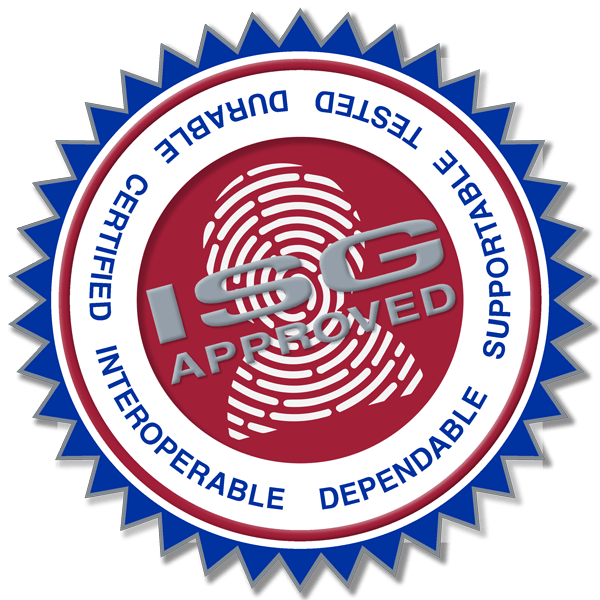This is the continuation of last week’s blog post, “The Ultimate Guide for Selecting the Right Photo ID System – Part I”. You can download the complete ISG White Paper here.
ID Card Printer Considerations
There are many different brands of card printers on the market today. The technology is now mature, and ID card printers all tend to be fairly reliable. There is a wide price range of card printers, however, based on brands and technologies, so what options are best for you?
Direct-to-card printers
This is the traditional printer technology, where the print head prints directly to the card using YMCK dye-sublimation ribbon technology. A clear topcoat (T panel) or overlay (O panel) is applied on top of the printing to provide some protection from general fading and wear. Direct-to-card printers are the fastest and least expensive printers. While they produce good quality printing, a downside is that they cannot print “over the edge”, meaning there is a small white border around the edge of the card, often at uneven distances. Exact color matching to your corporate Pantone color is also more difficult, as is printing a solid background color across the entire card.
Retransfer or “reverse image” printers
Retransfer printers produce the very best quality cards. If you are selective about producing the best quality and matching certain colors, then retransfer may be the best option for you. Retransfer printers operate by printing onto the clear polyester film in “reverse”, and then applying that film to the card via thermal transfer. This creates an “over-the-edge” print, where there is no white border on the card. The printed image is lithographic like, meaning it has a quality similar to process printed cards. The clear film is thicker than the topcoat/overlay used on direct-to card printers, so it is also more durable. A downside is that retransfer printers cost a bit more, are usually slower than direct-to-card printers, and ribbon prices are a bit higher. There is also the additional cost of the separate retransfer film. However, they normally have higher print quantities per roll, and are better for printing on cards with embedded technologies or security features.
Print resolution
Card printer print heads have produced 300 dpi cards for many years. Some card printers, mostly retransfer, are now available with 600 dpi printing. Generally, there is not a visually discernable difference in card quality, but 600 dpi is good for adding card security features such as micro text or UV images.
ID card lamination
As previously discussed, you will want to consider adding a lamination option to your card printer if you need your cards to last for a long time or resist fading due to continuous exposure to sunlight. You can also add a layer of security by including embedded in the laminate such as custom OVDs (Optical Variable Displays), micro text, or UV images.
ID card technology
Barcode printing is still a standard feature on all card printers through the ID card software. Magnetic stripe encoding is an option that is preinstalled when you purchase a printer, or sometimes can be added later. The same can be said for proximity or smart card encoders and readers. You should consider what technologies you use today, and which ones you are looking to add in the future, and plan accordingly with card printers that can handle both, either as preinstalled options or as modules that can be installed in the field.
Other ID card printer considerations
Speed, size, price, number of units, the availability of supplies, field upgrades for mag stripe or smart card encoders, manufacturer reputation, local support or depot service, extended warranties, and how long parts/service/supplies can be provided after product discontinuation are also important items to consider when making an ID card printer purchase. Also consider your total cost of ownership, such as the estimated number of reprints, lost cards, assumed lifespan, potential repairs, and historic print volumes to validate the right card printer purchase. Oftentimes, the cheapest solution may end up costing you more in the long run.
ID Database Considerations
While you can manually enter and store information directly into your photo ID system software, it will likely take a long time, especially if there are a lot of records, and have a significant risk of data error. It also means that you now have an isolated database to manage. When people no longer have active ID cards, they will need to be manually removed from that photo ID system database. It is better to import and share your ID data from a true/accurate data source, such as your existing HR (Human Resources) or SIS (Student Information System) database.
- You can import/export your database, but a direct database connection is usually the better choice.
- Does your true/accurate database have a field for the person’s photo?
- Would it be beneficial if the ID system could populate that field with a photo?
- Would it be beneficial to scan an image of the person’s driver’s license (instead of photo copying and putting it in a paper file folder)?
- Does your true/accurate database sync with other systems that need personnel and card data? Examples are time & attendance, door access control, library, cafeteria, parking, housing, etc.
- Do you need the ID system to perform the syncing with these other systems?
- Who needs to share your data?
Engage all stakeholders
The industry is abuzz with terms like “the convergence of physical and logical security” and “identity and access management (IAM)”. A discussion regarding the makeup of your ID database is an important part of these topics. You may want to engage your IT staff and other campus system decision makers, such as HR, auxiliary services and security, before selecting a photo ID system. Sharing updated information between all linked systems also speeds up the process for adding new cardholders or removing them when a card is deactivated. Dead spaces between systems can lead to security leaks, or having deactivated cards or invalid cardholders with active privileges.
Card Replacements or Temporary Cards
With a photo ID system, you can replace lost or stolen cards. Keep in mind that the old card needs to be deactivated not just in the ID system, but also in any other linked or related systems, like access control.
What about people that simply forget to bring their card with them? If you have a visual security program, they may still need identification. Many customers use an inexpensive desktop or mobile thermal printer (a few hundred dollars or less), and print temporary, one-day passes or ID labels to be worn. This is a good idea, as it still requires people to check-in and out for access and reinforces the importance of your security protocols. It is also a reminder to everyone just how important it is have their ID cards with them.
Create & View Reports
Most ID systems have the capacity to print out customizable reports that show various key data points such as the total number of records, the number records added or deleted in a given period, a breakdown of the types of access rights issued, the number of lost cards, etc. If the data is being stored in the system, then usually a report can be generated to show that information. Seeing the historic data on this kind of information can also help you plan supply purchases, downtime for maintenance or upgrades, and issuance trends for specific needs or technologies.
- What other people in your organization would benefit from being able to see the ID data and photos? Security, HR, IT?
- What reports would you like to produce? New employees, employee roster, class roster, etc.
ID System Security
ID system & card printer
Since an ID system might store or have access to important personal database information, it is important to keep it in a room that can be locked during off hours. Or if the ID system is in a thoroughfare with regular traffic, consider locking card hoppers and a printer lockdown cable. You should even consider options for a lockable cabinet to keep the hardware out of sight when not in use. The ID system itself should have individual user privileges assigned based on the level of access a particular user needs, such as an operator, guard or administrator.
Cards & supplies
These should be kept locked in a secure closet or cabinet, and in a climate controlled area. Ribbons and laminates especially can expire prematurely if there is too much direct light, heat or humidity. You should also keep an inventory log and routinely audit these items to control issuance and deter theft or waste.
Cameras
As mentioned in last week’s post, especially if you have a quality ID camera that may be expensive or is setup for high traffic captures, you should consider a locking mount to deter theft or tampering.
Software access & database
Employees that use the ID system can see important, and sometimes sensitive, data. You should take steps to protect access to data in the system. Individual logins should be used for the system (not a shared login), or you can easily add a two-factor authentication to the system.
Ribbon shredder
The used printer ribbons contain data. If the data is sensitive, you don’t want the used ribbon to be sitting in the trash can. An optional ribbon shredder is available to dispose of these ribbons. Even if you plan to recycle materials, it is best to shred them before turning them over to the recycler, as cardholder information might still be visible on the used materials.
Installation & Support
Installation
You can always order a prepackaged system via the internet, but then you will have to spend several hours (or maybe days) installing and figuring out how to use it. There are a lot of things that need to be done correctly, especially if integrating with other systems like HR, SIS, access control, etc. We believe it is much more efficient to have an expert come to your site to perform the installation, complete the setup, and provide operator training.
Support, depot or on-site?
If you do purchase via the internet, you received the manufacturer’s product warranty, which means that you will have to ship it back to them for any repairs. This is a very big pain! You have to talk to an 800 number, remove cards and supplies from the printer, box it (hopefully in the original packaging) and ship it out. If you are lucky, the shipping will be free.
Not only that, but you cannot make new or replacement cards while the printer is gone, unless you purchased backup hardware. When the printer is returned, it may be a different serial number, meaning you have to update your organization’s asset list. Sometimes, the problem turns out to not be the card printer, but something else entirely, so shipping the printer was a wasted effort. Sometimes, the card printer still doesn’t work once it is returned, and you are stuck in the same mess.
With an on-site maintenance agreement, an expert technician will come to your location to correct the problem, whether it is the card printer, the software, the camera, a combination of items, or something else. This gives you true peace of mind and saves a lot of time and effort on your part.
There is no doubt in our mind that on-site installation and ongoing support is the best and most efficient method. Without having a sensible solution in place for your needs, problems could occur that might affect the system’s security, the integrity of your data, and/or your capacity to issue cards.
Get the Right Photo ID System for Your Organization
A photo ID system is just one part, albeit a very important one, of your overall security plan. You need to be sure that you are making the best decision for your organization, and plan to install, integrate and implement it correctly. Talk to your local ISG ID systems expert for advice on the best available options.


